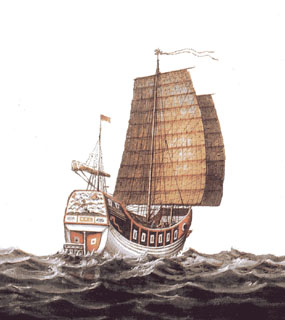 From
the 14th century China's merchant fleet had been trading with the countries
of South East Asia and further afield usually through Arab and Persian traders.
The Chinese traded silks, lacquer ware and porcelain for spices, rare woods,
metals and other raw materials. In the 16th century the Portuguese merchants
established entrepots in the Far East and thus more Chinese products reached
Europe. In 1600 and 1602 respectively, the English and Dutch East India
Companies were set up and by 1650 the Dutch East India Company had become
dominant in the Far East. From
the 14th century China's merchant fleet had been trading with the countries
of South East Asia and further afield usually through Arab and Persian traders.
The Chinese traded silks, lacquer ware and porcelain for spices, rare woods,
metals and other raw materials. In the 16th century the Portuguese merchants
established entrepots in the Far East and thus more Chinese products reached
Europe. In 1600 and 1602 respectively, the English and Dutch East India
Companies were set up and by 1650 the Dutch East India Company had become
dominant in the Far East.
 Chinese
porcelain was in demand because, except for Korea and Annam (Vietnam),
nowhere else was this high fired, hard and durable ceramic obtainable.
The porcelain industry was mainly centred around the Imperial kilns at
Jingdezhen and was an important source of revenue for the government.
Thus the Chinese export trade evolved. Some wares were specifically manufactured
for the Islamic market, some to the taste of the South East Asian countries
and yet others to the requirements of the Europeans. There was also a
significant group of wares made for the Japanese market. Chinese
porcelain was in demand because, except for Korea and Annam (Vietnam),
nowhere else was this high fired, hard and durable ceramic obtainable.
The porcelain industry was mainly centred around the Imperial kilns at
Jingdezhen and was an important source of revenue for the government.
Thus the Chinese export trade evolved. Some wares were specifically manufactured
for the Islamic market, some to the taste of the South East Asian countries
and yet others to the requirements of the Europeans. There was also a
significant group of wares made for the Japanese market.
By the beginning
of the 17th century the Ming dynasty in China was in decline. The Emperor
was a weak ruler and the country was run by the eunuchs who imposed heavy
taxes. There was agrarian unrest and eventual civil war, which ended the
Ming dynasty in 1643. However, in the period from 1650 to 1680 the output
of the porcelain industry in Jingdezhen fell drastically as a result of
continuing civil disturbances. This led the Dutch and Chinese merchants
to seek porcelain from Japan.
|
